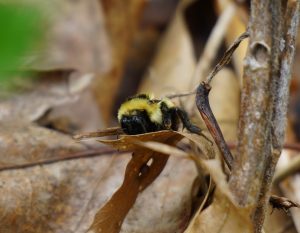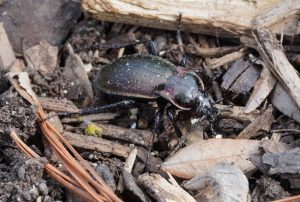By Berit Erickson of The Corner Pollinator Garden and Wildlife Habitat blog
As the weather warms up, we’re all itching to get outside to work in the garden. Not so fast. Before you haul out the rake and leaf bags, consider how cleaning up impacts pollinators and other insects. By holding off on spring garden clean-up, by changing how you do it, and by doing less of it, you’ll create valuable habitat for pollinators and increase insect biodiversity.

My backyard garden after minimal spring clean-up. Soon new plant growth will cover the leaves.
A question of timing
You’ve probably heard that it is ecologically beneficial to “leave the leaves” and avoid cleaning up your garden in the fall. Well, what should you do in the spring? You’ll find recommendations to hold off cleaning up your garden until daytime temperatures warm consistently to 10°C or 15°C, or to wait until the Victoria Day weekend, or for apple trees bloom, and so on. However, it is actually most beneficial to not clean up your garden at all.
A blog post by Douglas Tallamy, Leaf litter: love it and leave it (March 30, 2021), revisits the topic of spring garden clean-up. Tallamy explains that insects don’t all emerge at the same time; some continue to develop within the shelter of fallen leaves throughout the spring and summer. He recommends that we leave the leaves permanently.
However, it isn’t realistic for urban gardeners to not clean up their gardens at all. Despite the ecological benefits, if you don’t do anything, you’ll look like you’re neglecting your yard, and you may end up irritating your neighbours or by-law officials. Instead, a more balanced approach is to redefine what it means to clean up your garden in spring, instead of not doing anything.
Leaves are year-round shelter and habitat
Contrary to conventional thinking, leaves aren’t litter to be thrown away – they’re actually shelter and habitat for pollinators and other creatures. Leaving leaves in the garden boosts urban biodiversity by creating and maintaining this essential habitat.
Many species of butterflies and moths overwinter in leaf litter as caterpillars or pupae. However, since different species develop at different times in the spring and summer, no matter when you bag leaves, you risk tossing away future butterflies and moths.
For example, in late summer fritillary butterflies lay their eggs on dried leaves near violets, their host plant. After the eggs hatch, the tiny caterpillars overwinter in the leaves. The following spring, fritillary caterpillars wake up, find nearby violets to eat, and continue to develop. Removing leaf litter near violets removes the fritillary eggs and caterpillars along with it.

A bumblebee queen in my garden that crawled out from leaves to warm up in the sun before flying away (May 2, 2021).
Butterflies and moths aren’t the only pollinators that shelter in leaves. After bumblebee queens emerge from their underground overwintering spots, they find shelter in leaves until they start nesting. On cool days when temperatures drop too low for them to fly, bumblebee queens hide out from predators and rain. See the Wild Pollinators blog post, Another good reason to hold back on “cleaning up” the garden, for more information.
Besides pollinators, leaves are habitat for many insects and other creatures either year-round, or during part of their life cycle. The PDF booklet Life in the Leaf Litter, from the American Museum of Natural History Center for Biodiversity and Conservation, illustrates the diversity of life that is found in leaves. Close examination of leaf “litter” samples reveals beetles, spiders, slugs, snails, worms, centipedes, and millipedes, as well as fungi and microscopic organisms.
Continue leaving the leaves
The conventional way to clean up gardens in the spring is to remove all remaining leaves, cut back perennial stems to the ground, and put it all into leaf bags destined for the curb. Then, mulch is spread to make the garden look tidy, and to replace the organic matter than was just taken away. Not only is this typical approach detrimental to the pollinators and other life that depend on leaf litter for shelter and habitat, but it’s also a lot of unnecessary work.
Continue leaving the leaves in the garden – with exceptions. Instead of removing and bagging leaves, you can simply move them elsewhere in your garden or yard. This is a compromise between removing all plant matter permanently, and not doing any clean up at all. Use your judgement – it doesn’t have to be all or nothing.
If leaves are too thick and matted together, they can smother new plant shoots trying to poke through. In my front garden, oak leaves form an impenetrable layer in some places. I lift thick mats of leaves and move them to out-of-view places, such as the middle or back of the garden, under the hedge or hedgerow, or to the compost bin. In other areas, I simply fluff up the oak leaves to loosen them and create gaps for light, rain and emerging plants to penetrate. Maple, basswood, and birch leaves in my backyard are much lighter and don’t smother plants the way oak leaves do, so I leave these in the garden as is.
To please my neighbours and fastidious family members, I remove leaves from the edges of garden beds that can be viewed from the sidewalk and seating areas and along paths. Where I remove leaves, I add my own compost or composted mulch to make it look tidy.
Wherever their location in my yard, the leaves help retain moisture, prevent soil erosion, and add organic matter to the soil as they break down. I now save money and labour because I’m not filling and hauling dozens of leaf bags, or buying and spreading yards of mulch.
Avoid using leaf blowers or leaf shredders because these tools disturb leaves where insects are sheltering or living, or can harm or kill the insects.
Leave stems too

Cut pithy stems to 12 to 15 inches tall to create nest sites for bees. Here, Small Carpenter bees are digging out an Ironweed stem to create a nest (April 12, 2021).
Typically, when we clean up our gardens, we cut back perennials to ground level. Instead, if you cut pithy or hollow plant stems to 15 inches, they can be used as cavity nests by solitary bees.
Some stems that are used for nests include Joe Pye Weed, Cup Plant, sunflowers, goldenrods, coneflowers, Swamp Milkweed, bee balms, raspberries, elderberries, roses, and sumac. In my garden, I have seen small carpenter bees digging out Ironweed and Purple Coneflower stems to create nests.
New plant growth will soon cover the awkward stems in the garden. Again, instead of putting old plant stems and other debris into leaf bags, I drop them on the ground or move thick woody stems to the back of the garden. Like the leaves, this material will eventually decompose and enrich the soil. Wiry steams are too small for bees to nest in, and they tend to stick out in all directions, so I chop them up with secateurs and drop them around the garden.
Some butterflies, such as swallowtails, attach their chrysalids to stems to pupate. Before I move or chop up stems, I check for chrysalids to make sure I don’t damage any.
An advantage of leaving stems a foot or so tall is that they help keep remaining leaves in place in my garden, instead of blowing away into my neighbours’ newly-raked lawns.
Berit Erickson is a member of the Wild Pollinator Partners network and creator of The Corner Pollinator Garden and Wildlife Habitat.


